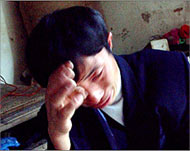China’s disturbing suicide trend
Mrs Han lived in an impoverished region of central China. Her daily chores included managing an eight-member household as well as doing regular labour in the fields.

Her husband started having a relationship openly with a woman from a neighbouring village, often giving away his money to her.
Trapped in a patriarchal rural society that discouraged divorce, and with her complaints going unheeded, Mrs Han took her own life by swallowing fertiliser, a common method of suicide in rural China.
Despite this, the husband continued his affair, passing the family chores on to his daughter, aged 16. Unable to tolerate constant criticism from her brothers and beatings from her father, she too killed herself by taking poison a year after her mother.
By no means unique, these deaths highlight a growing problem of zisha or suicide, within China’s changing society.
Recent government statistics suggest there are 250,000 suicide deaths a year or about 20 per 100,000 population, placing China well above the global average of 14.5 per 100,000.
Incomplete statistics
The statistics are incomplete as China lacks a complete death registration system. A 1998 World Health Organisation report estimated 413,000 suicides per annum, roughly 30 per 100,000 deaths.
“What can be said is that China is unique in the world in having a higher ratio of female to male suicides and a higher ratio of rural to urban suicide. In rural areas, the female suicide rate is 25% higher than men’s.”
 |
|
Most suicide cases can be prevented |
Confounding Western norms where urban male suicides are the most common, Dr Michael Philips explains that in East Asia as a whole there is little gender difference in suicide numbers, but that China with its noticeably higher female suicide rate, remains something of an enigma.
Based in the far north of the city, Philips heads the Beijing Suicide Research and Prevention Centre, one of only a handful of Chinese institutions dedicated to the study of self-inflicted deaths.
Philips and his team conducted surveys across Northern China with those who had attempted suicide and their families. Results showed that approximately 50% of interviewees (among both males and females) cited marital problems as the precipitating reason.
“I was surprised by some of the findings. Many of the popular theories such as the mother-in-law, educational worries among young adults, and depression brought on by forced abortions, although present, were simply not sustained by the statistics to be considered as major reasons why people take their own life,” Philips said.
Disability
In one case cited, a 47-year-old father with a permanent disability requiring expensive treatment took his own life after hearing his daughter had been accepted into university. He decided it would be better to spend the little money they had on securing his daughter’s future.
“We found that in 37% of cases the interviewees apparently showed no signs of mental disorder prior to trying to killing themselves. These people reacted to varying social conditions, all of them saying that within a few minutes of the precipitating incident they tried to kill themselves,” Philips said.
“When the public think of mental illness,” he explained “they think of people running around screaming. They do not equate it with depression, nor do many people even know what depression is, it will simply be an alien term in some areas.”
Suicide as a research topic became politically acceptable only in the late 1980s and even now the field of psychology carries stigma for both patients and practitioners – symbolic of its potential for controversy, the Chinese name for the Centre has replaced the title word “Suicide” with “Crisis”.
What the centre has done is set up China’s first free hotline dedicated to answering depression related issues.
 |
|
Suicides in Chinese urban areas |
“We are not sure how many lives we may have saved, certainly there were a few people who appeared on the brink and we talked them out of it. For the most part, people just need a release and we give them that opportunity to discuss their psychological issues,” explained Philips.
In June, they fielded 1188 calls, but as coverage grew through television appearances and public awareness campaigns this had grown to 12,000 by September, only a third of which they were able to answer.
Access
In many parts of China, particularly rural areas where suicide is most prevalent, access to telephones is not always easy. Here, people can only rely on local heath services, but when it comes to psychiatry, few doctors have the necessary expertise.
“At the moment local hospitals have little psychiatric skills, they just send people home without any proper consultation,” exclaimed Philips.
“If one looks at the burden of health that mental health represents, then it is about 20%. Compare that with the 2% of medical health funding it receives, then there is a problem,” he added.
In central Beijing, Dr Luo Hechan, an octogenarian, is considered the oldest psychologist in China. Working in the early eighties, he began using electric acupuncture as a form of depression treatment.
“When a patient comes in, I will give them a diagnosis which will often include suggestions on lifestyle changes and prescriptions for herbal and Western medicines as well as acupuncture.
“We place needles on top of the head and in the temple in order to stimulate the brain. An electric current of about 40 volts is then applied for a period of 45 minutes,” said Hechan.
|
“Suicide is now on a par with AIDS in terms of how the government is talking about it“
chief, Beijing Suicide Research and Prevention Centre |
Like any form of acupuncture, the science is hazy and Dr Luo confessed he himself did not fully know what was happening inside the brain once the patient was plugged in. His patients though seem convinced.
Concentration problems
Sitting with three needles stuck into her head, one middle-aged woman explained the effect the treatment was having on her.
“I would take three sleeping pills and then manage to sleep two to three hours. The result was that I had no energy and I was frustrated and angry during the day. Now, after eight sessions I feel much better and have reduced my pill intake to one,” she said.
Another young man complained of concentration problems at work causing him feelings of anxiety and muscular pains. He too claimed to be feeling the benefits of the treatment through improved mental performance.
“Ideally, we need to set up a national suicide prevention plan, we need to work on a programme that will get this issue in front of the State Council, only then will we start to see results,” said Philips.
“Suicide is now on a par with AIDS in terms of how the government is talking about it,” concluded Philips. “I hope that like AIDS, we will move upwards along the same curve.”